
1860s NYC: The Civil War Era, Metropolitan Advancement & Cultural Evolution
The 1860s were a pivotal decade in New York City’s history, marked by profound transformation and resilience. This era, significantly shaped by the Civil War, had a lasting impact on the city’s economic and social framework. As a crucial hub for manufacturing and commerce, New York City played an essential role in supporting the Union army, solidifying its position as a key player in the war effort.
During this period, New York City’s urban landscape underwent significant changes. The completion of Central Park in 1858 and its official opening in 1861 introduced a groundbreaking concept for urban public spaces, blending natural beauty with city life. The 1860s also saw the expansion of the city’s infrastructure, notably the development of its iconic street grid system, which became a defining feature of modern New York.
Culturally, the 1860s were a time of remarkable diversity in New York City. The city continued to attract a large number of immigrants, who enriched its cultural fabric with diverse languages, traditions, and customs. However, this period also brought challenges, including issues of inequality, social strife, and the complex aftermath of the Civil War.
In summary, the 1860s were a decade of significant change in New York City, laying the groundwork for its evolution into a global metropolis. The advancements in infrastructure, culture, and industry during this era were crucial in shaping the city’s unique identity, reinforcing its legacy as a center of innovation, diversity, and resilience.
Timeline of New York City’s History in the 1860s
Discover surprising historical facts about The City That Never Sleeps—explore fun, educational insights into its history, population, iconic landmarks, and more, perfect for students, history enthusiasts, and anyone curious about NYC’s rich heritage.
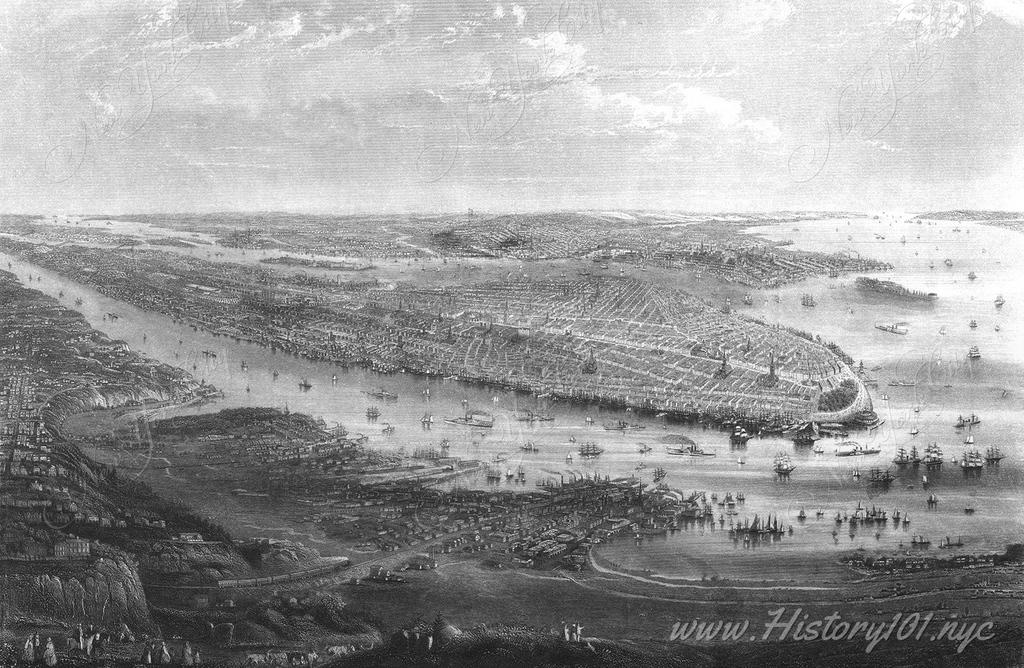
1868: Panoramic View of Manhattan and New Jersey: A Window into New York's Urban Past
Explore a panoramic 1868 illustration of NYC and NJ, revealing the urban and architectural development of New York's historical landscape
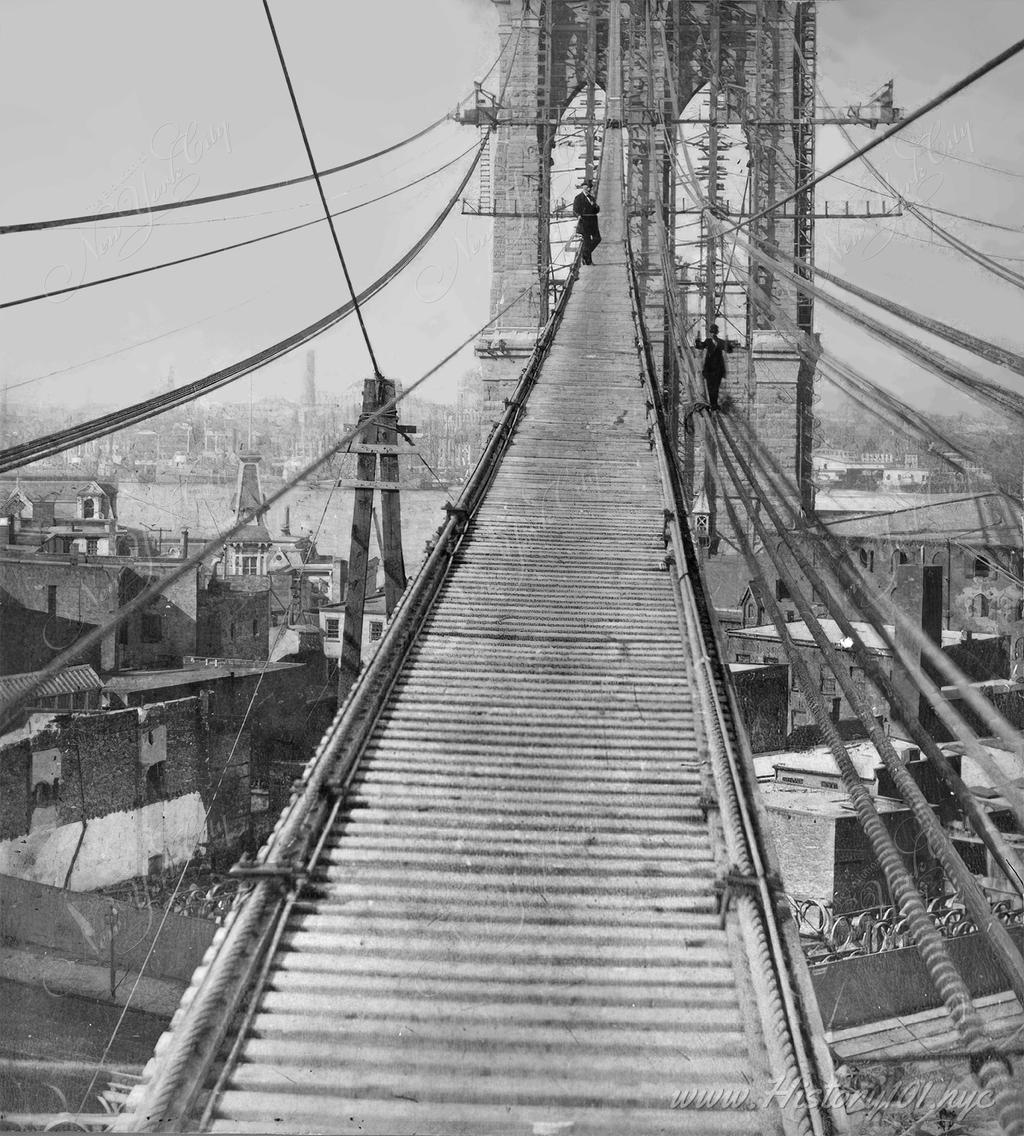
1869: The Brooklyn Bridge: A Landmark Achievement in Civil Engineering (1869-1883)
Discover the 1869-1883 construction journey of Brooklyn Bridge, a pivotal engineering breakthrough linking Manhattan and Brooklyn
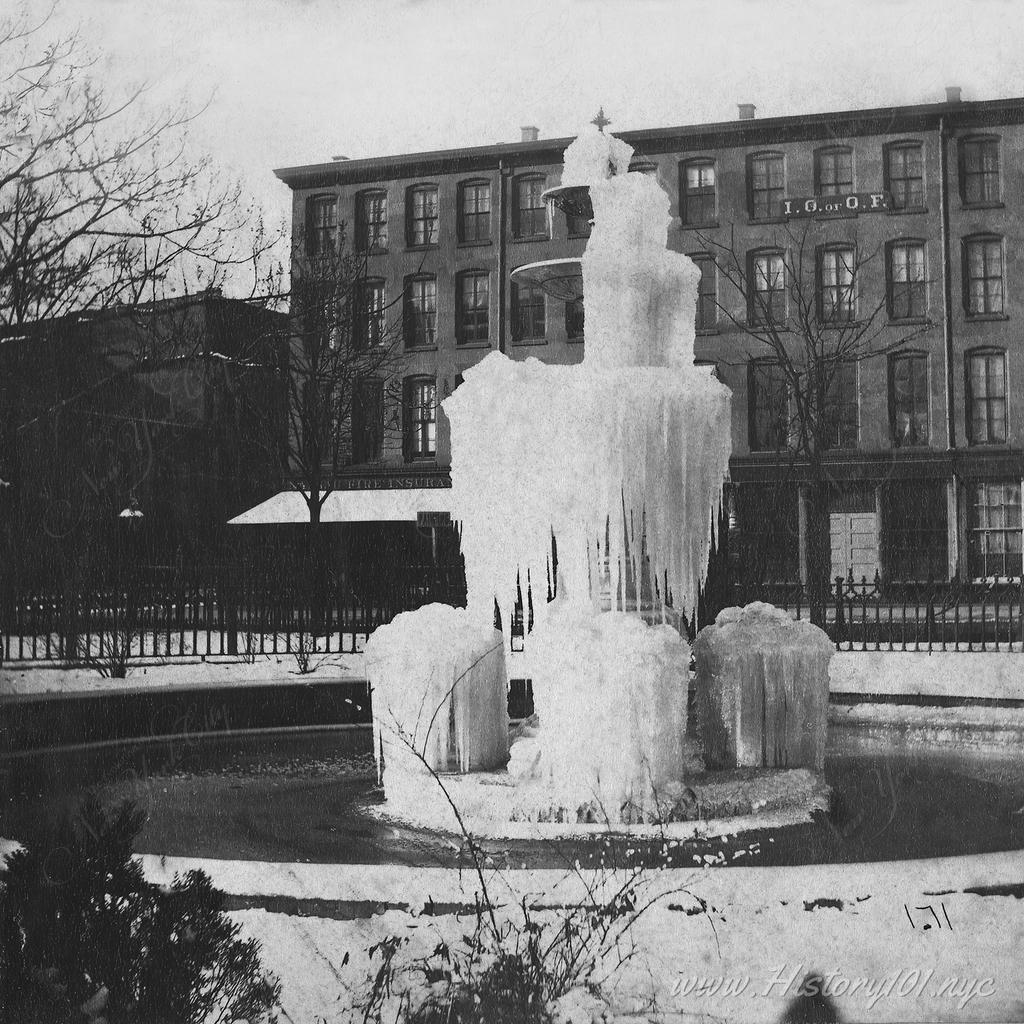
1860: Jack Frost in Brooklyn
Photograph of a frozen fountain in a Brooklyn neighborhood during the winter.
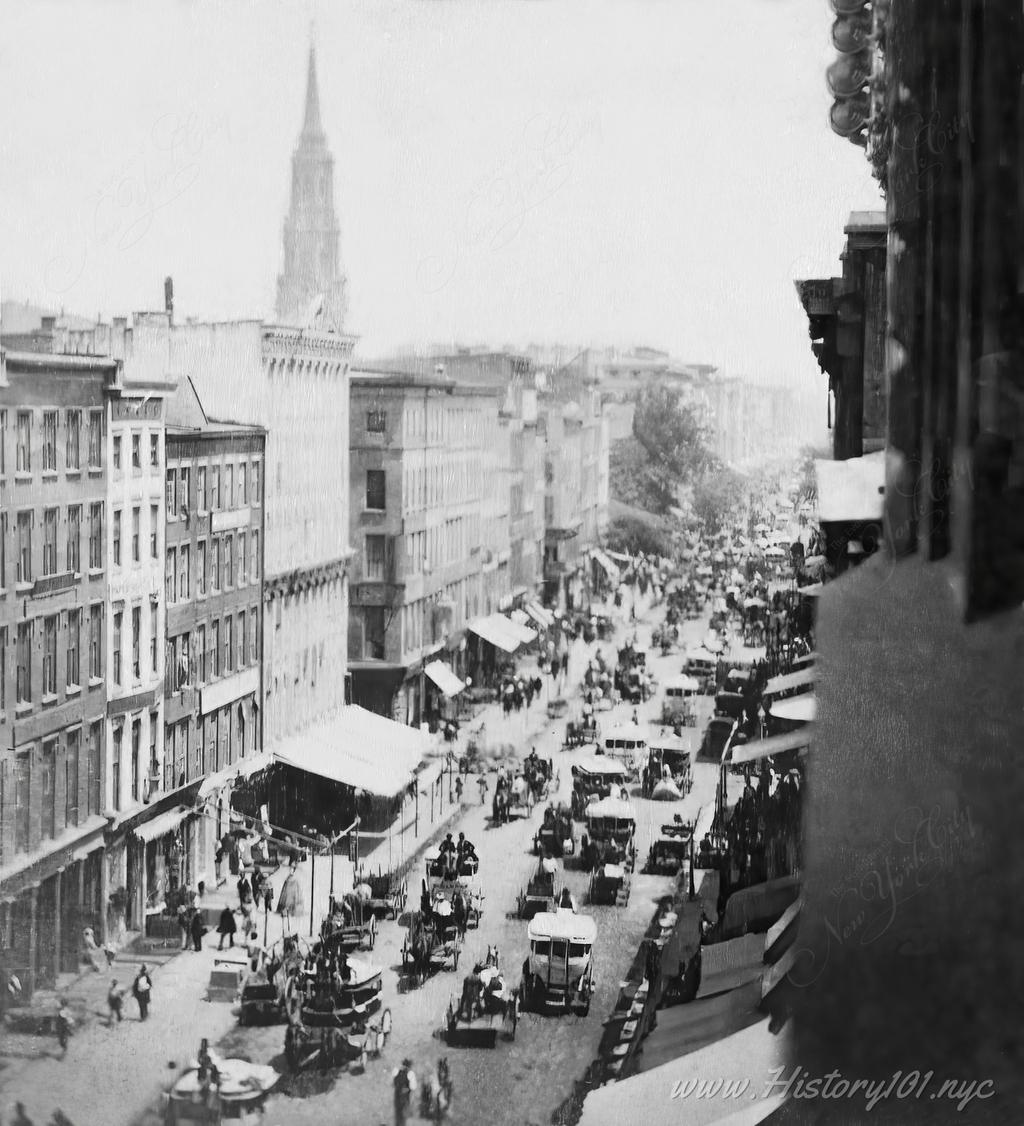
1865: Exploring New York: George Stacy's Iconic Broadway View
Discover 1865 NYC through Stacy's Broadway photo, capturing the city's vibrant streets and commercial evolution
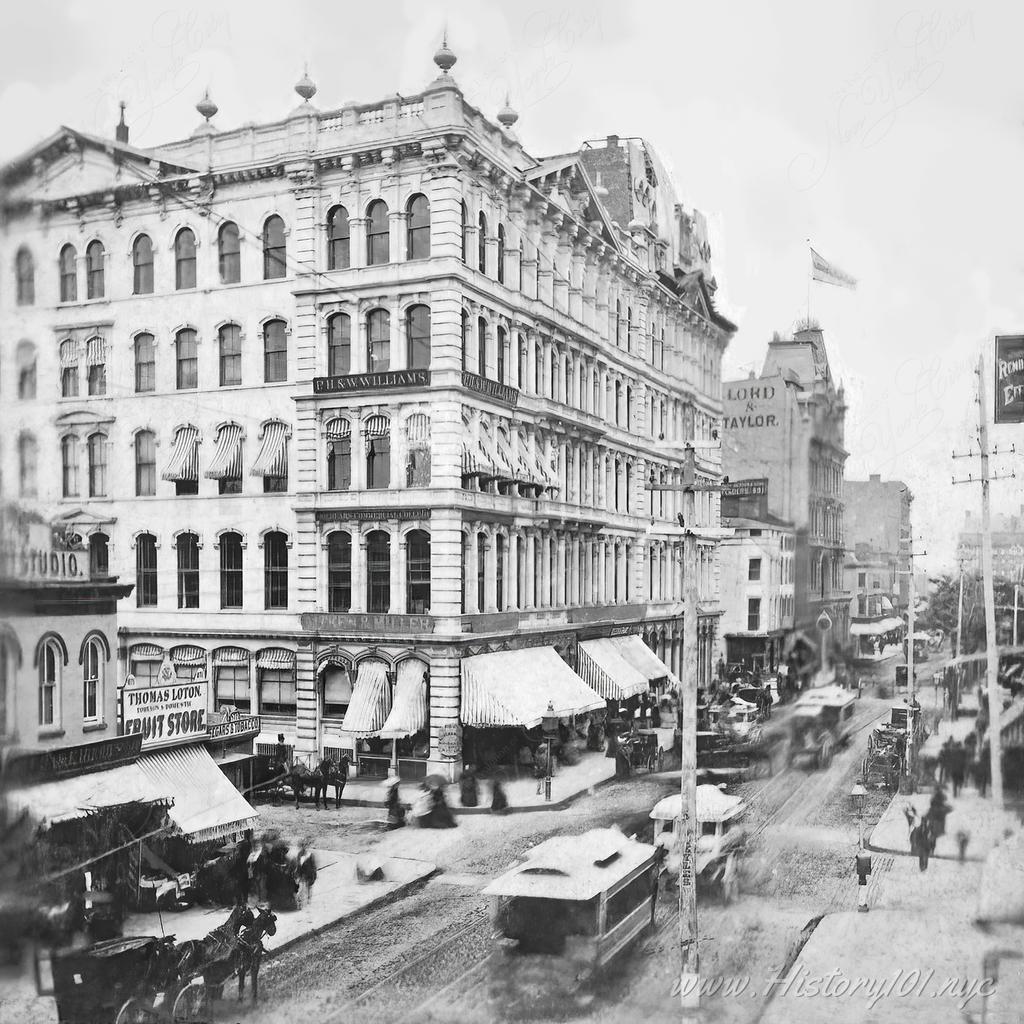
1860: Instantaneous Broadway View
A slightly elevated perspective of a bustling street known as Broadway, which remains a hub of commerce and culture to this day.
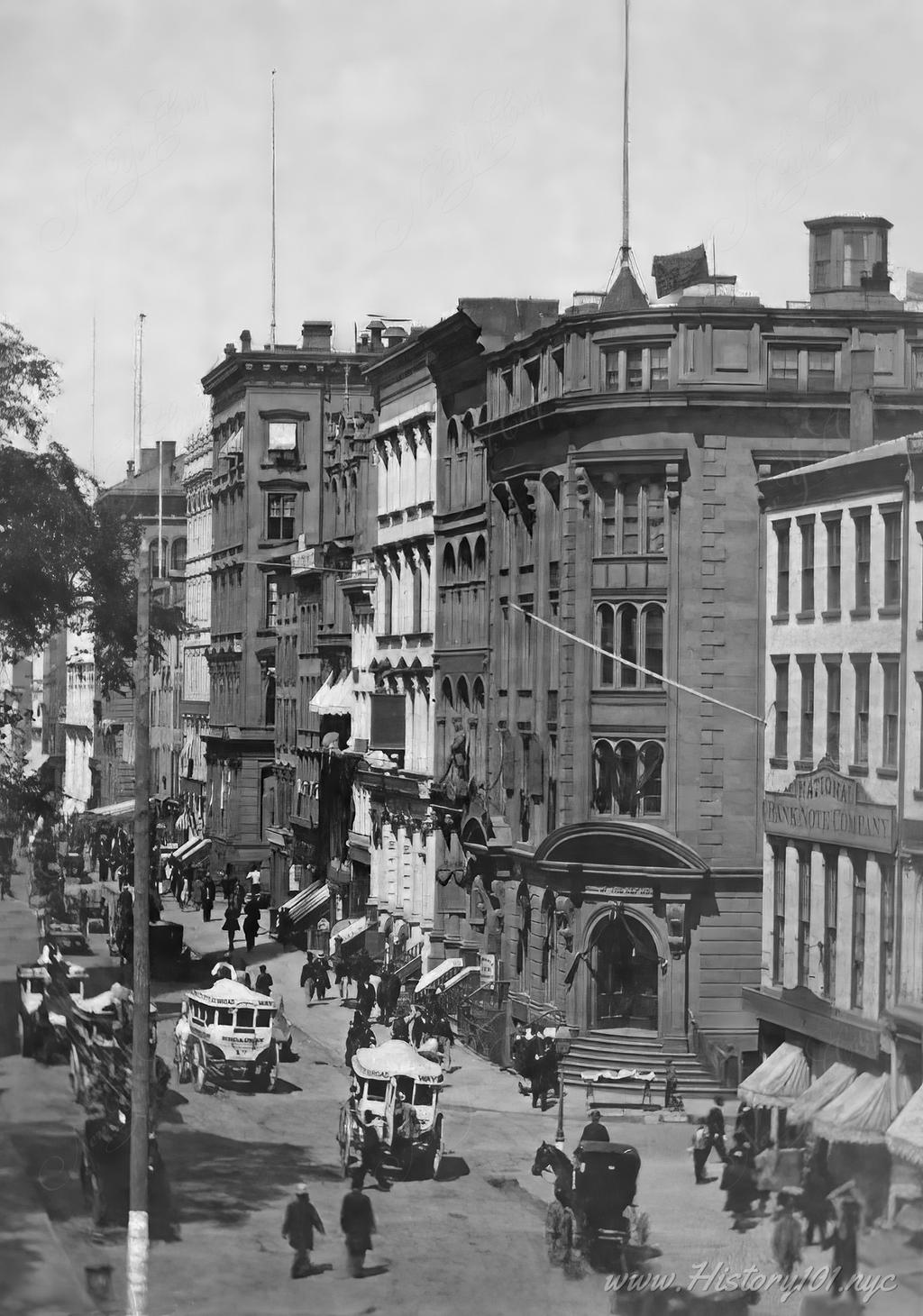
1865: Broadway and the Bank of the Republic, NYC
Photograph taken in 1865 shows the "National Bank of the Republic" (NBR) surrounded by other commercial buildings, pedestrians and traffic on Broadway.
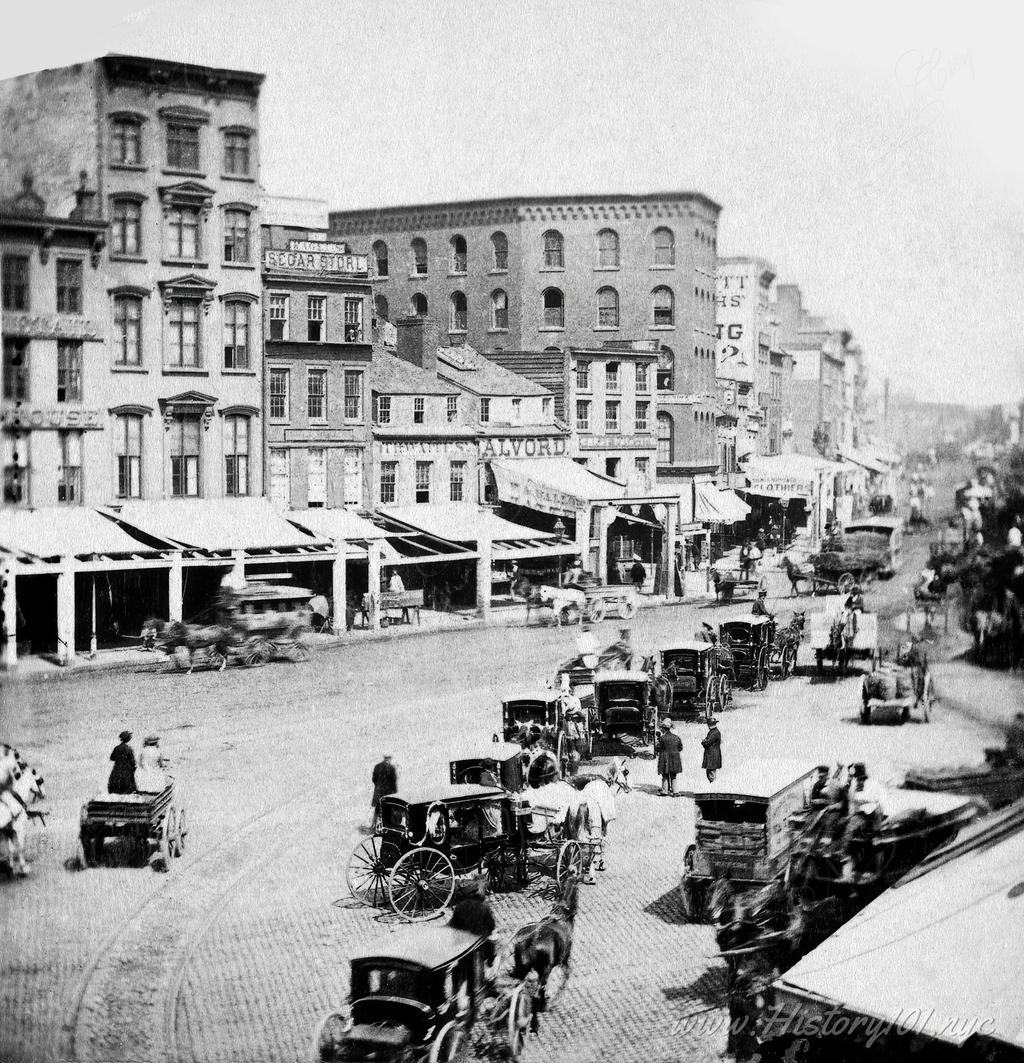
1860: Chatham Square in New York City: A Glimpse of Urban Life with Storefronts and Horse Wagons
Explore a photograph of 1860s Chatham Square, NYC, showcasing bustling storefronts, pedestrians, and horse-drawn wagons in a vital commercial hub of Lower Manhattan
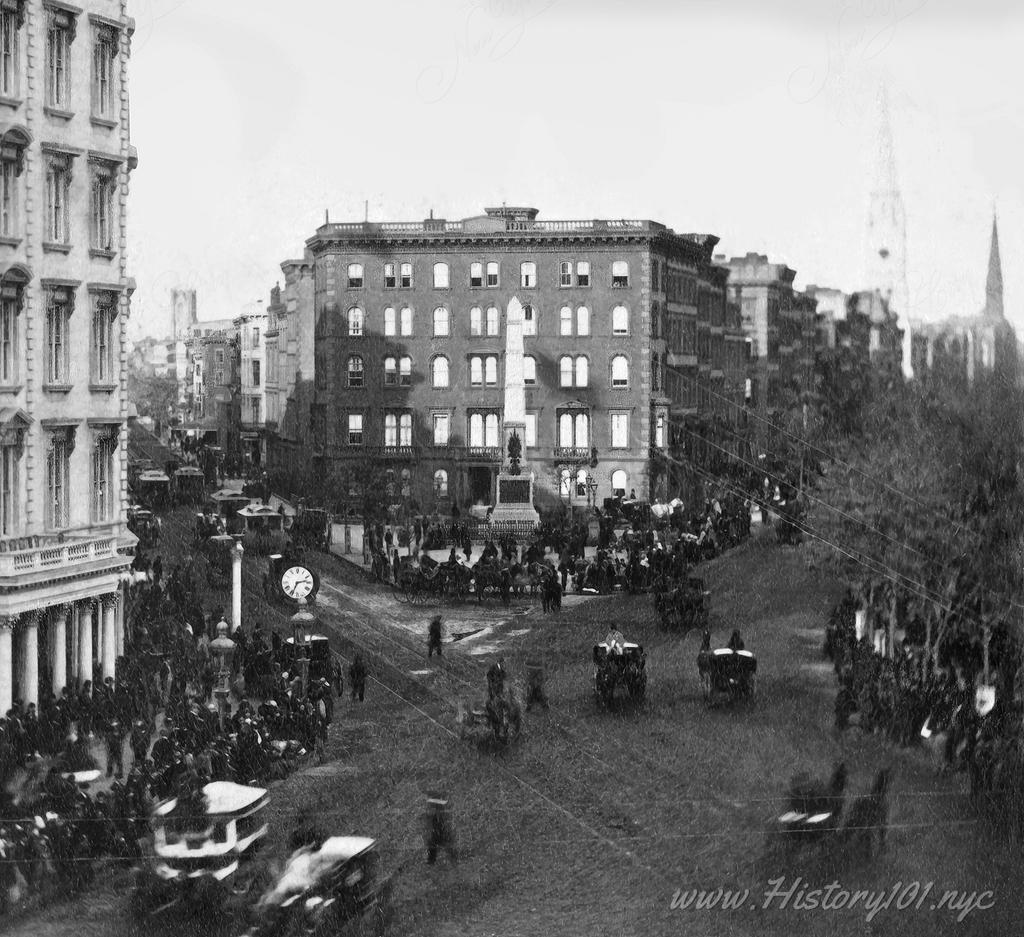
1865: Aerial View of General Worth Square
Aerial View of General Worth Square on 25th Street between Broadway and Fifth Avenue. It is the second oldest monument in any New York City park.

1860: Police Officers in Uniform
Group portrait of policemen, standing in rows in front of a Metropolitan building with their hands crossed in front of them and guns resting at their sides.
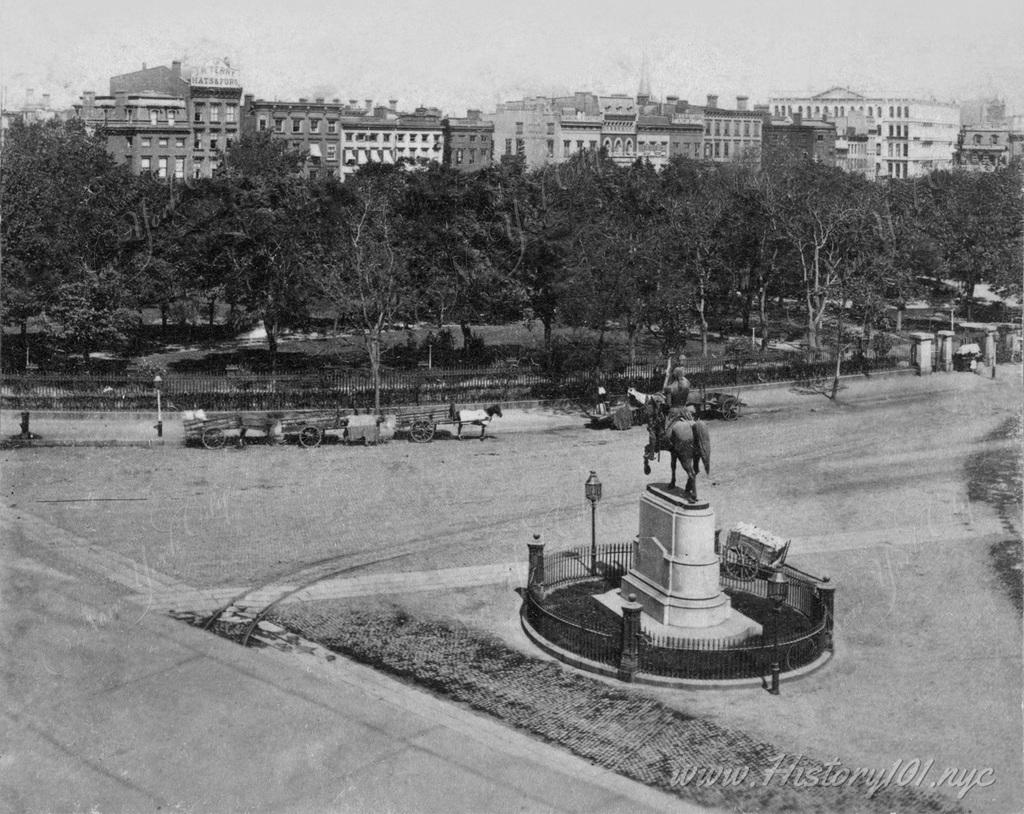
1860: Aerial View of Union Square
A view of 14th Street and 4th Avenue looking northwest over the Washington's Equestrian Statue at Union Square, New York City.

1863: Church of the Ascension, NYC: A Gothic Revival Pioneer on Historic Fifth Avenue
Discover the Church of the Ascension, an 1841 Gothic Revival gem, and its role in shaping Fifth Avenue and Manhattan's architectural heritage
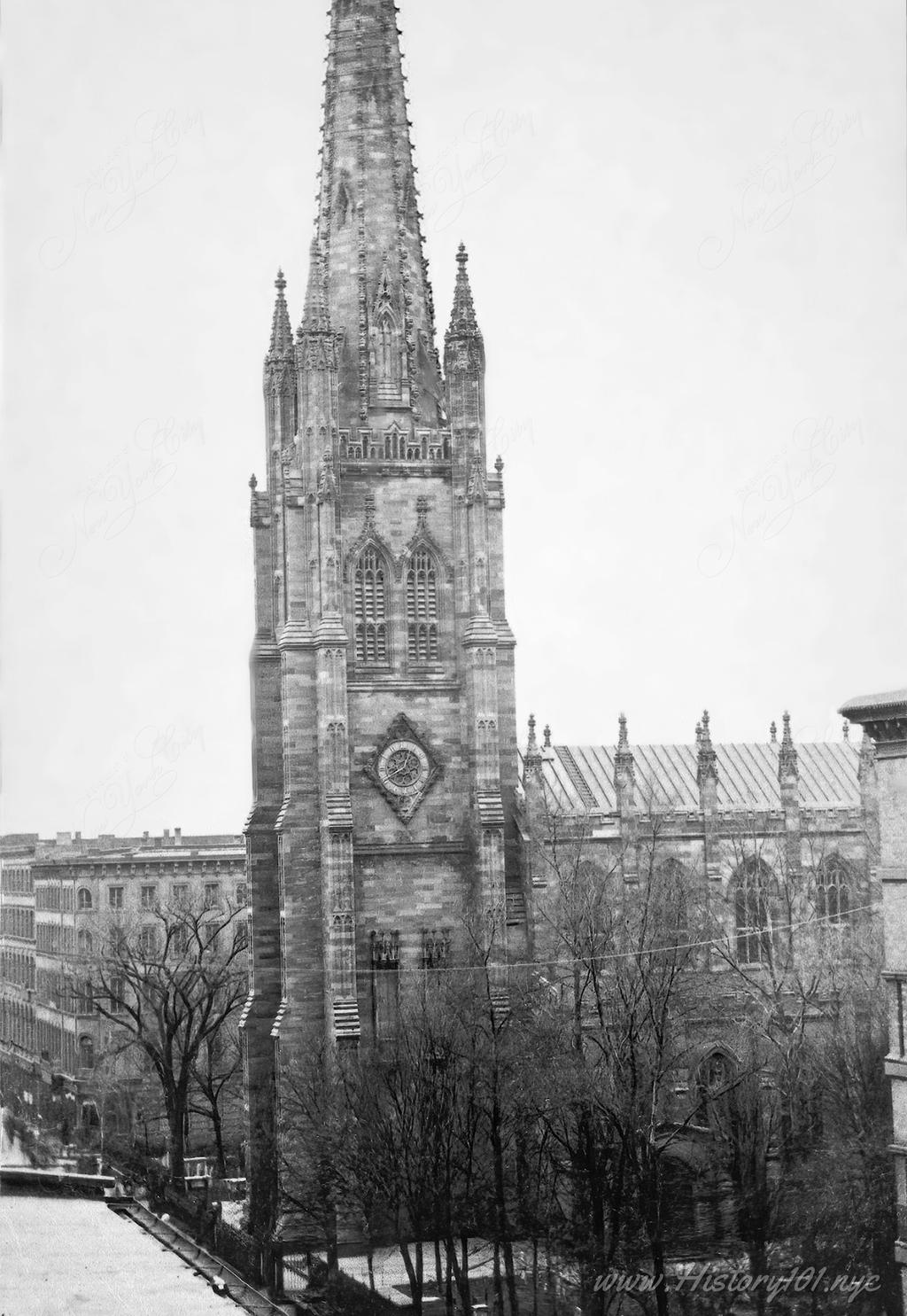
1863: Trinity Church
An early photograph of Trinity Church on Broadway next to Wall Street. Taken by George Stacy in 1863.

1869: Scene of Squatters Living near Central Park
An artist's rendering of Squatters near Central Park living among farm animals in their shacks.
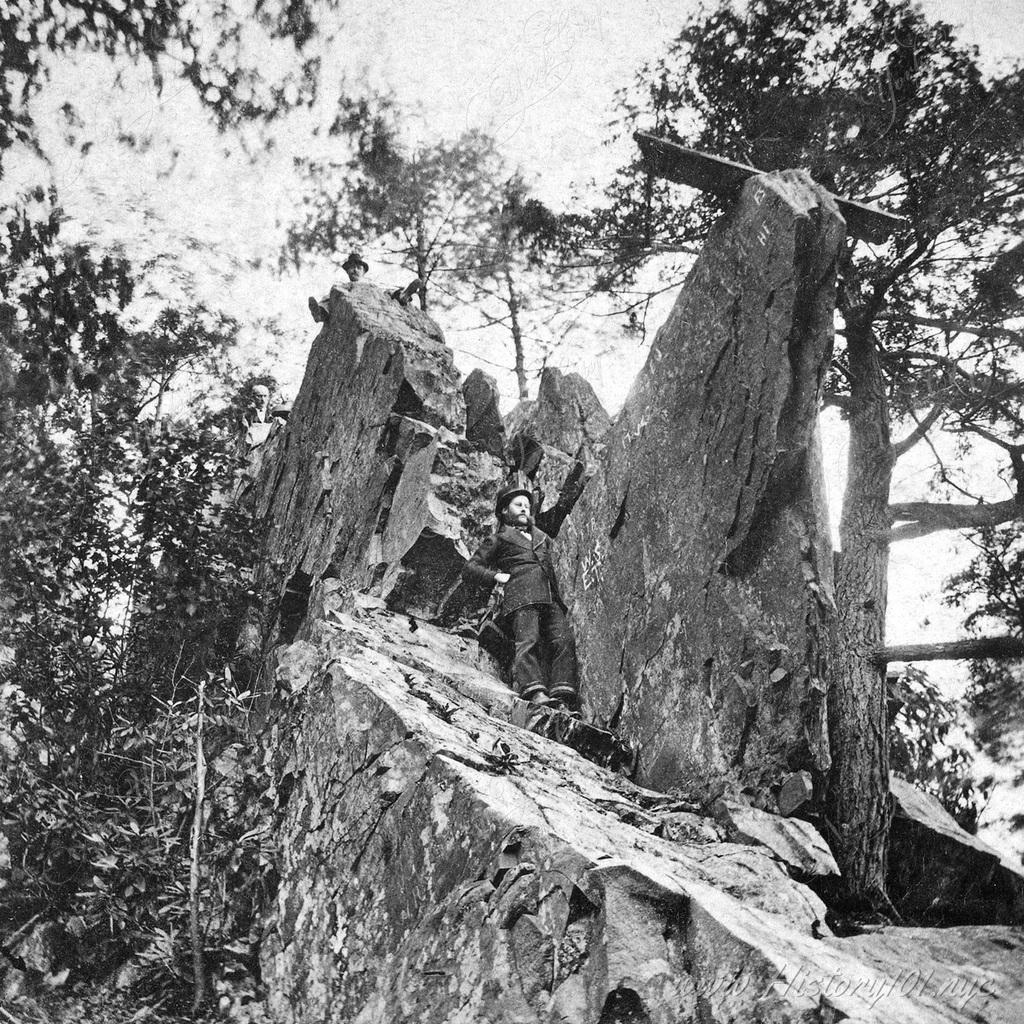
1865: Prospect Rock at Prospect Park
Photograph of a man in a suit perched atop one of the prominent rock formations at Prospect Park, Brooklyn.

1865: Hudson River Highlands
This amazing photograph of the Hudson River in the year 1865 gives us a glimpse into the ancient topography of New York City.
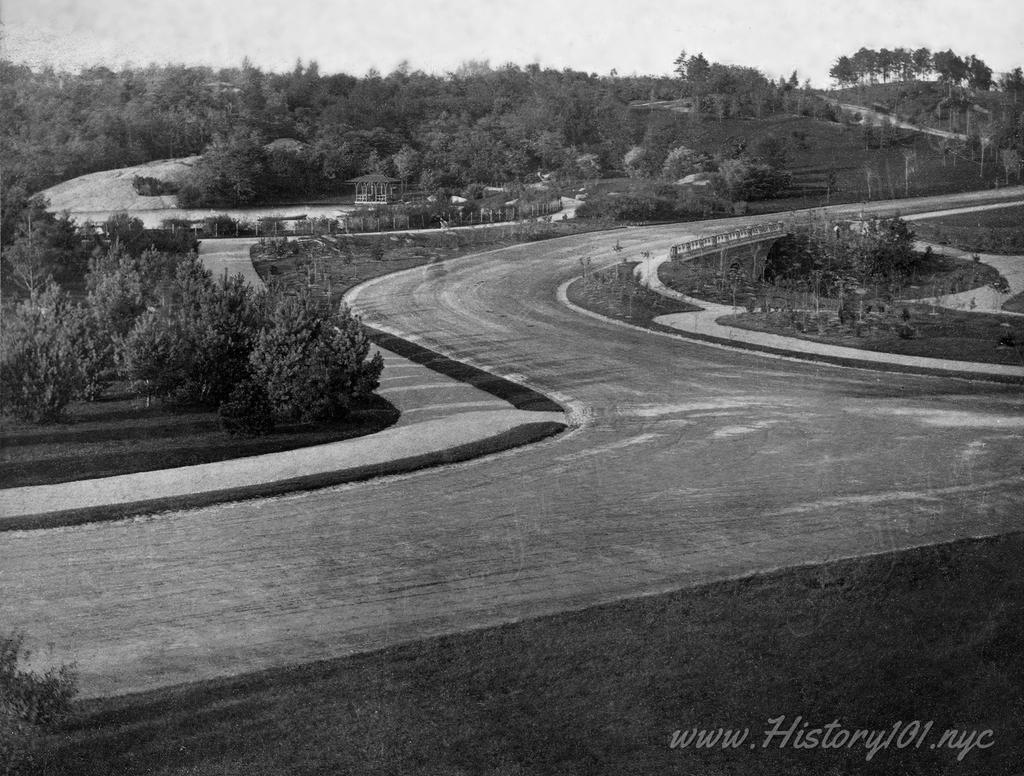
1865: Elevated View of Central Park
A photograph of Central Park in its pristine and far less developed stage, compared to what we know today.

1865: Central Park Archway: Capturing NYC's Historic Essence in George Stacy's Lens
Explore George Stacy's ca. 1865 photograph of Central Park, featuring a man on a bridge above an arched footpath, showcasing historic NYC
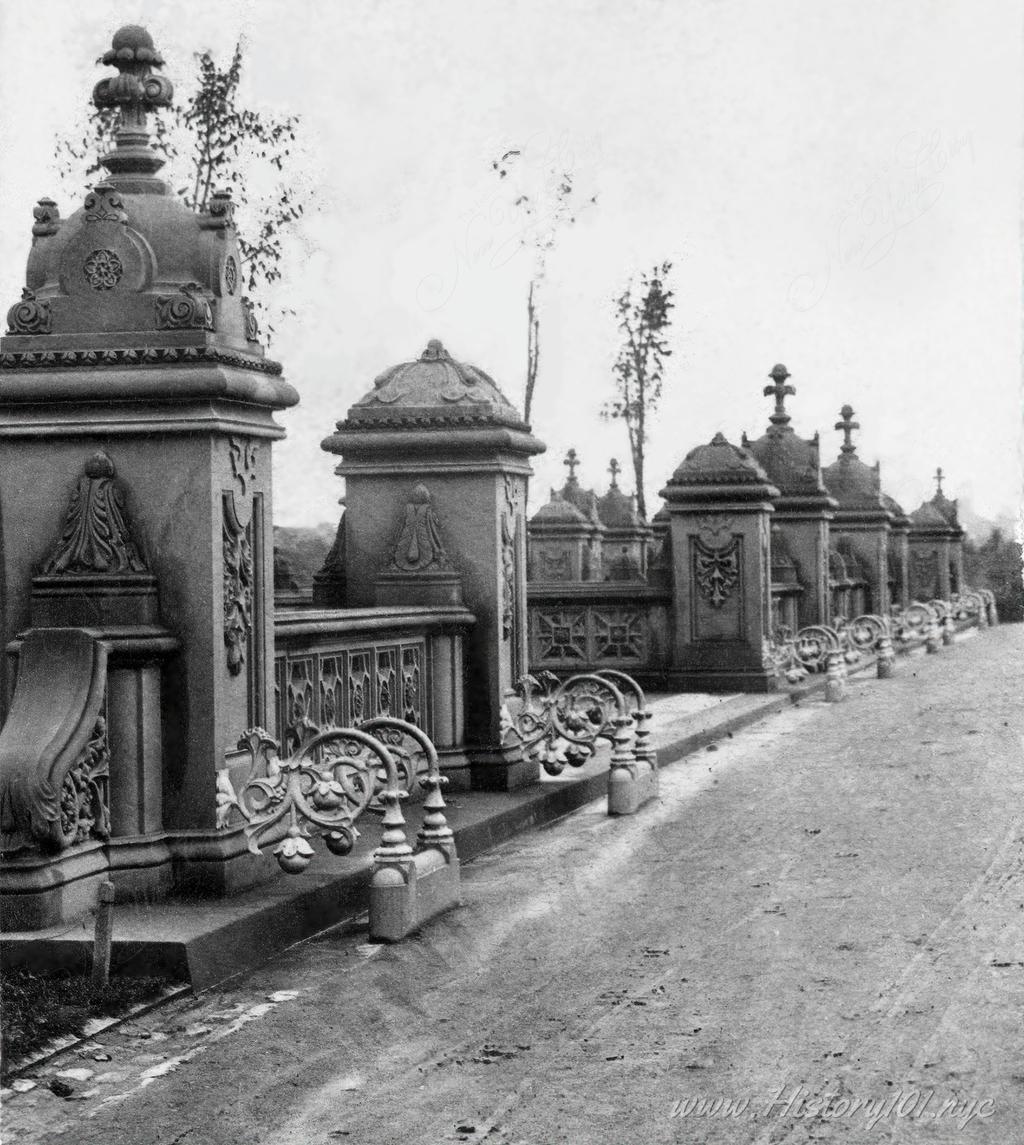
1865: Central Park Stonework
A unique perspective revealing the ornate patterns of Central Park's stonework designed by Frederick Law Olmsted and Calvert Vaux.
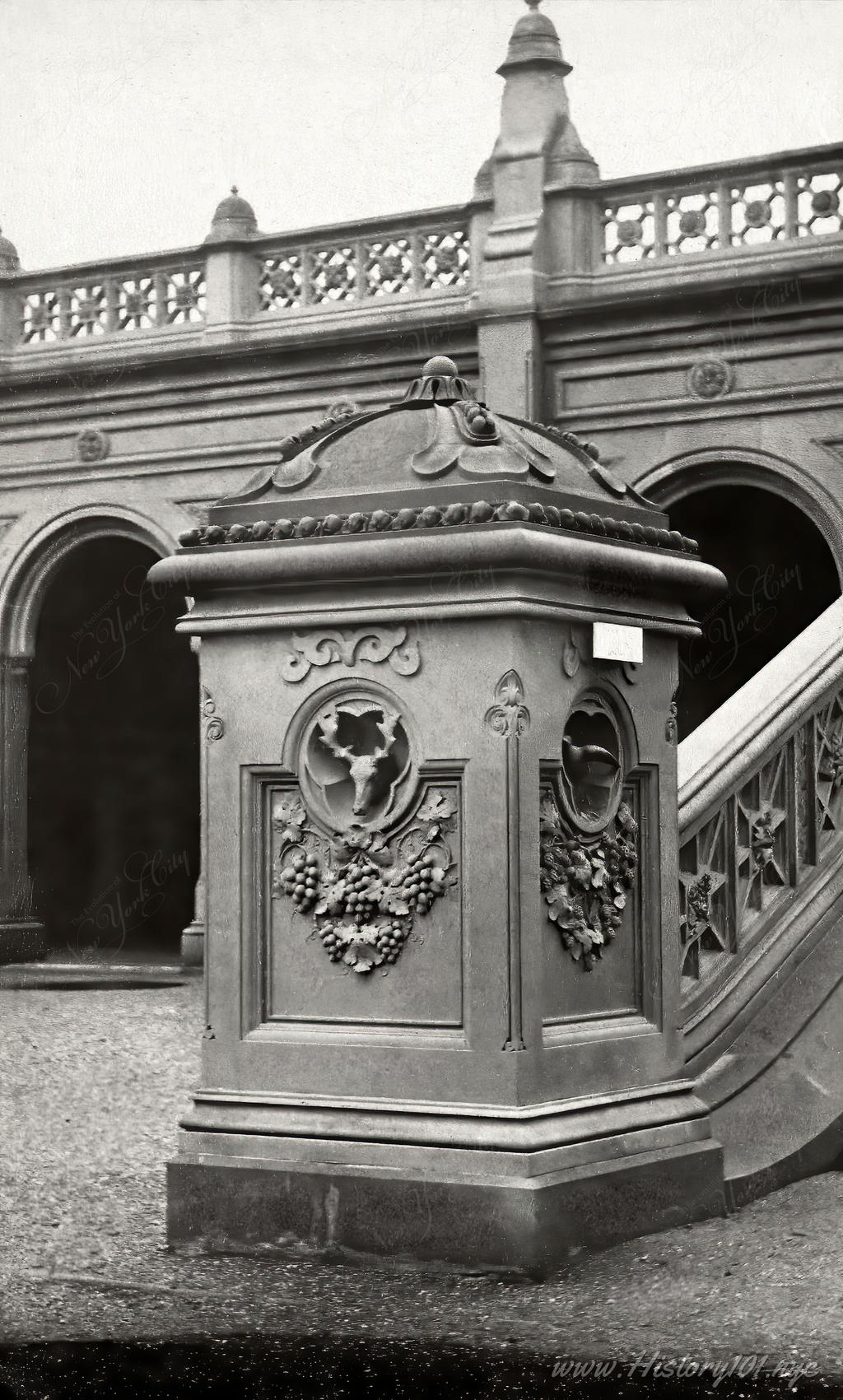
1865: Central Park Terrace Stone Work
A detailed view of Central Park's terrace masonry. The terrace was one of the very first structures to have been built in the park.
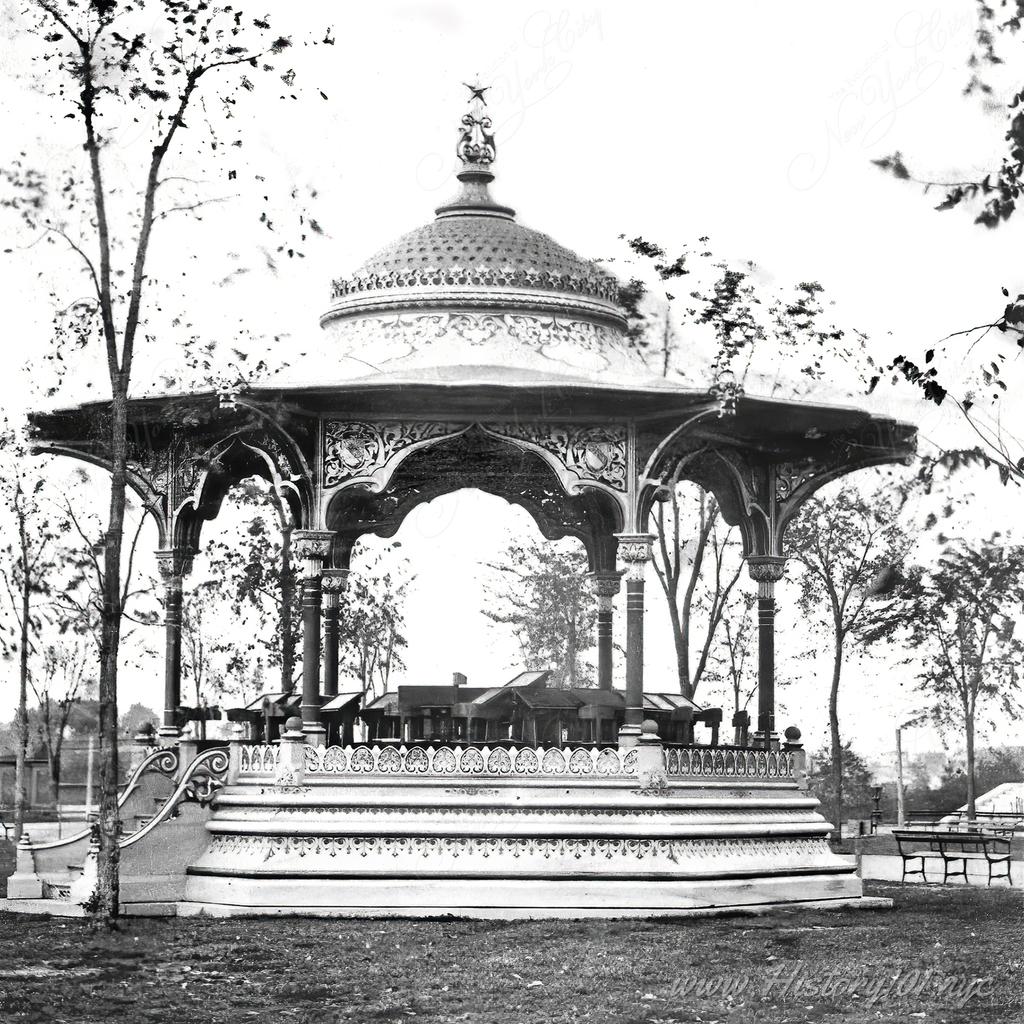
1865: Music Pavilion in Central Park
A photograph of the Music Pavilion on a quiet and overcast autumn day. Taken by George Stacy in 1865.

1869: Manhattan Market on West 34th Street
The Manhattan Market was located on 34th to 35th Streets and 12th Avenue (future site of the Jacob Javits Convention Center).

1863: George Washington Statue at Union Square, NYC
Photograph by George Stacy showing the bronze sculpture of George Washington by John Quincy Adams Ward, originally installed at Federal Hall National Memorial.

1868: Aerial View of Union Square and 4th Avenue
Instantaneous Panoramic View of Union Square, flanked on the right side by the famous electric trolley cars that once served as mass transit.

1868: Union Square and 4th Avenue During Rush Hour
A northeast view of Union Square and 4th Avenue crowded by trolleys and pedestrians during peak hours.

1868: Light Traffic at Union Square and Broadway
Aerial view of Union Square on an overcast morning. The streets are sparsly dotted with pedestrians and street cars.

1868: Northern View of Union Square and Broadway
A photograph shows a famous intersection of downtown Manhattan, lined with trolleys and a vastly different urban landscape.

1870: The Equitable Building: 1870 Innovation to 1916 Catalyst for Zoning Laws
Uncover the pivotal role of NYC's Equitable Building, from its 1870 elevator innovation to driving the 1916 Zoning Resolution

1860: New York Post Office
General post office on Broadway and Park Row. The building is characterized by arched windows and columns on each level.

1861: Stores on the Corner of Pearl & Chatham
An illustration of a busy corner of downtown Manhattan. The corner of Chatham and Pearl Streets were home to many markets and storehouses.

1860: New York Historical Society and Museum Proposal
Painting by Richard Morris Hunt shows a conceptual sketch of a potential new home for The New York Historical Society, where the current Parks Department is located.

1869: Underground Lodgings for the Poor at Greenwich Street
Illustration by Celia Orgel depicting a homeless shelter. Housing was often organized by local communities to provide food and shelter to those most in need.

1869: South Street Seaport, Piers 17 & 18
Piers 17 and 18, located in the South Street Historic District Extension, stand as physical evidence of the water-oriented economy of NYC in its early years.
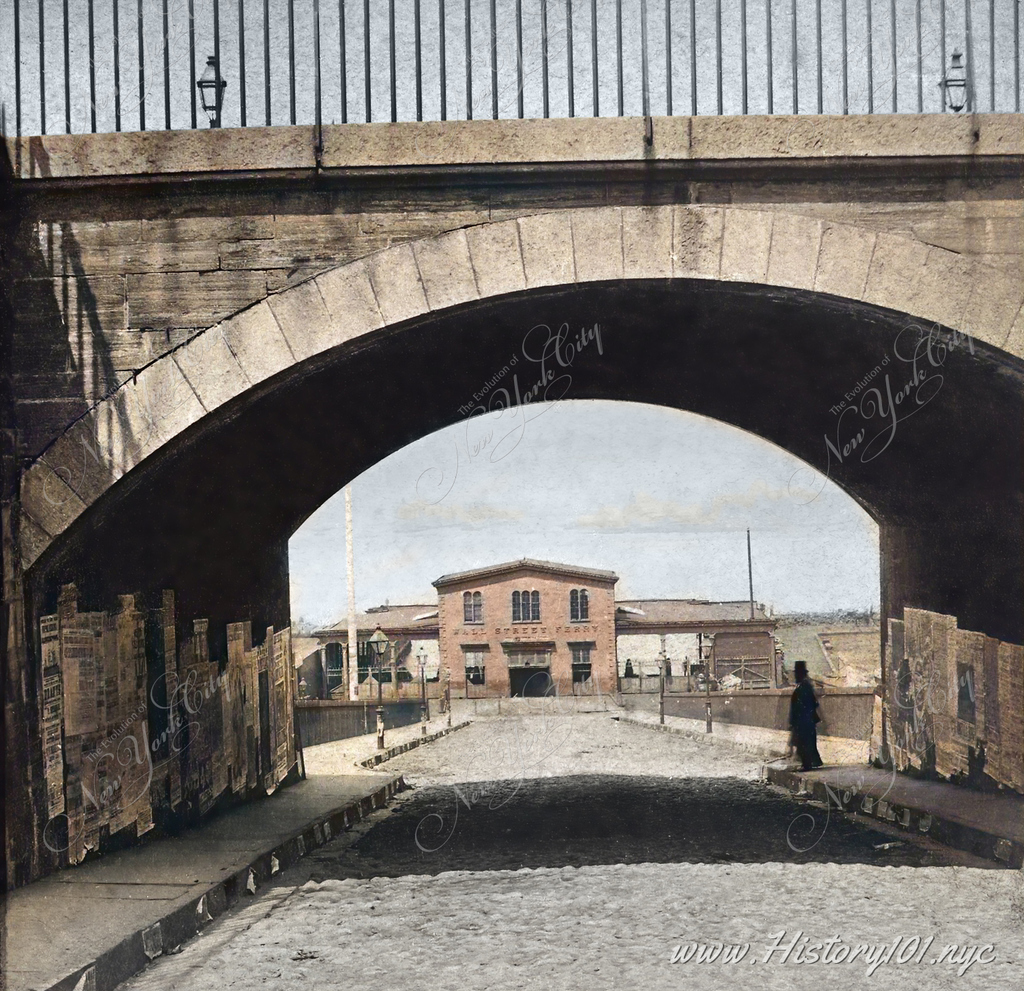
1869: Wall Street Ferry & Brooklyn: A Glimpse into Historic New York City
Discover 'Wall St. Ferry, Brooklyn, New York in Distance,' a 1869 photograph capturing the City's essence through a mix of activity & tranquil moments

1865: 23rd Street and Broadway - Madison Square Park
Photograph of the Fifth Avenue Hotel, across from Madison Square Park, New York City.

1860: The 5th Avenue Hotel
Photograph shows the Fifth Avenue Hotel, across the street from Madison Square Park, New York City.
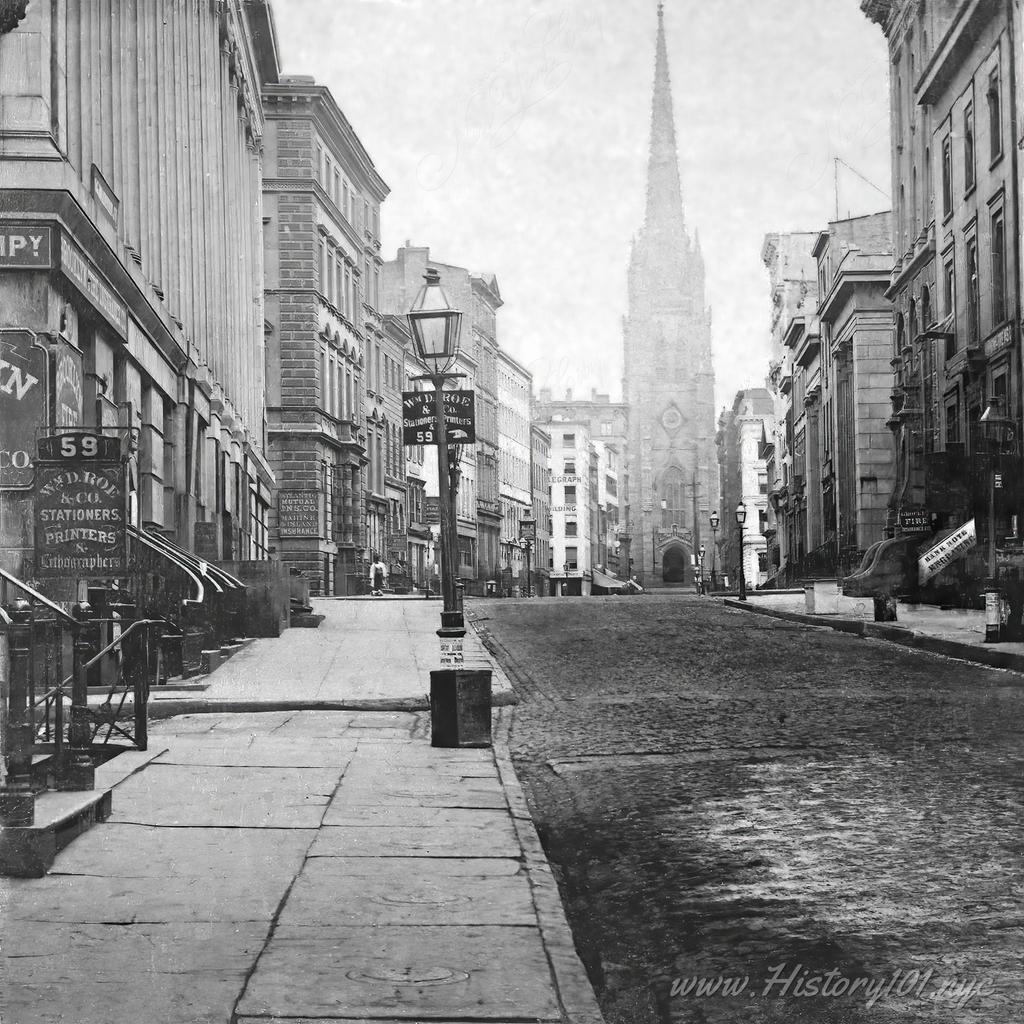
1860: Wall Street, New York
View of Wall Street with storefronts and Trinity Church in the distance. A sign of printer "Wm. D. Roe & Co." (at 59 Wall Street) is visible in the foreground.

1860: Everett House on Park Avenue
Everett House was a first class hotel which opened in 1853 and used to exist among the private residences surrounding Union Square.

1860: Parade on Broadway near Union Square
An aerial photograph shows a large crowd of spectators enjoying a parade on Broadway.

1863: Peter Stuyvesant's Pear Tree: A Symbol of NYC's Colonial Past
Discover the story of the Stuyvesant pear tree, a symbol of NYC's transformation from Dutch colony to modern city, standing from 1647 to 1867

1868: The Domestic P.M. Company Building
A photograph showing the building of the Domestic P.M. Company, located at Union Square, New York City.

1863: South Street Seaport
View south looking down Fulton Street at pier 17 and the north elevation of the Fulton Ferry Terminal at South Street Seaport, Piers 17 & 18, South Street.
Timeline of New York City: 1860-1870
1860: New York City's population surged to 813,669, fueled by European immigration, notably from Ireland, Germany, and Italy, making it the largest U.S. city. This demographic shift, part of a broader 19th-century migration wave, led to vibrant ethnic enclaves like Little Italy and the Lower East Side. These groups infused the city with diverse cultures and traditions, defining its identity. Despite challenges such as overcrowding, poverty, and disease, efforts to improve living conditions emerged, including the creation of public parks and the establishment of an education system.
This influx catalyzed cultural enrichment, economic growth, urban development, and social reforms, laying the foundations for modern urban planning and public health. Consequently, NYC's transformation during this era solidified its global stature as a nexus for commerce, culture, and immigration, profoundly impacting its historical and cultural evolution.
1860: Engineered by Isambard Kingdom Brunel, the "Great Eastern," the world's largest ship at the time, embarked on its first voyage to New York City in 1860. Spanning over 680 feet and weighing more than 18,000 tons, the ship featured advanced technology such as combined steam and paddle wheel propulsion, and a double hull for enhanced stability. Its luxurious amenities included a 400-seat dining hall and a music room equipped with a grand piano.
The arrival of the "Great Eastern" in New York City marked a significant moment in the 19th century, highlighting the city's burgeoning role as a global maritime hub. Although the ship did not succeed commercially and was later repurposed as a cable-layer, its inaugural journey to New York significantly enriched the city’s maritime history. Decommissioned in 1889, the "Great Eastern's" debut voyage remains a pivotal event in New York City's historical narrative.
1860: On February 1, Rabbi Morris Raphall made history as the first rabbi to open a session of the United States House of Representatives with prayer. Serving as the rabbi of Congregation B'nai Jeshurun in New York City, his participation in this national event highlighted the growing acceptance and inclusion of diverse religious practices in American political life.
This significant moment benefited New York City's historical narrative by showcasing its rich religious diversity on a national platform. Rabbi Raphall's involvement from New York City reinforced the city's reputation as a center for progressive and inclusive values. This event not only marked a milestone in religious representation in American politics but also emphasized New York City’s influential role in shaping a culturally diverse and accepting society.
1860: Established on October 10, the New York World newspaper quickly rose to prominence in American journalism. It originated in New York City, becoming a defining voice in the media landscape through the late 19th and early 20th centuries. This publication marked the start of its significant influence in shaping public narratives and political discussions.
The inception of the New York World was a key moment in New York City's journalistic and cultural history. It played an instrumental role in molding public opinion, chronicling major events, and steering political conversations, thereby cementing its legacy as a vital contributor to the city's heritage and the broader progression of American journalism.
1860: On August 8, Queen Kamāmalu of the Sandwich Islands, now known as Hawaii, arrived in New York City. This visit was part of a broader diplomatic mission aimed at strengthening relations between the Kingdom of Hawaii and the United States. Accompanied by her husband, King Kamehameha IV, Queen Kamāmalu's journey to America was intended to foster diplomatic and economic ties, and New York City was a key stop due to its prominence as an international port and cultural hub.
The visit of Queen Kamāmalu to New York City highlighted its significance as a global metropolis capable of engaging with international dignitaries and playing a role in global diplomacy. This event not only brought international attention to the city but also showcased its capacity to be a center of significant cultural and political interactions. Hosting the Hawaiian royalty added to New York City's rich historical tapestry, reinforcing its status as a cosmopolitan city deeply involved in the cultural and diplomatic exchanges that shaped the 19th century.
1861: On January 6, Fernando Wood, the Mayor of New York City, made a controversial proposal suggesting that New York City should secede from the Union to become a "free city." His proposal aimed to maintain neutrality during the burgeoning conflict between the North and South, allowing the city to continue its lucrative trade relationships with both sides. As the Civil War loomed, Wood's proposal was rooted in economic concerns, reflecting the city's heavy reliance on commerce that was threatened by national divisions.
While the proposal to make New York City a free city was never enacted, it highlighted the city's critical economic position and its deep commercial ties with both the Northern and Southern states. This episode is a notable instance of New York City's unique stance during a pivotal moment in U.S. history, demonstrating the city leaders' willingness to consider radical measures to protect local economic interests. The situation underscores New York's role as a major economic hub, keen on safeguarding its financial stability amidst national turmoil.
1861: On April 20, the "Great Union Meeting" at Union Square became one of New York City's largest Civil War-era public gatherings, with 100,000 participants. It showcased the city's shift towards Union support, featuring Mayor Fernando Wood and others urging for unity and military enlistment, accompanied by patriotic songs and speeches. This event marked a pivotal change in the city’s stance on the war.
Preceding this, on April 19, the Sixth Massachusetts Regiment's arrival in New York, post a confrontation with a pro-secessionist mob in Baltimore, was met with a celebratory parade down Broadway. These two events underscored New York's crucial role in the Civil War, not in battle, but through significant political backing and troop contributions, reflecting its impact on the Union's effort.
1861: Founded by Gustav Schirmer, Sr, G. Schirmer Inc. rapidly became a leading entity in America's music publishing landscape. Based in New York City, the company specialized in a broad array of music from classical to contemporary genres, significantly enriching the city’s cultural and artistic tapestry, especially in music.
From its inception, G. Schirmer Inc.'s impact was instrumental in establishing New York City as a major hub for musical arts and commerce. The company's commitment to supporting and promoting musicians and composers greatly enhanced the cultural scene of New York. Its sustained presence and achievements have continuously highlighted New York’s role as a center of creativity and artistic expression in the music industry, reinforcing the city's reputation as a bastion of artistic innovation.
1861: The American Civil War began at 4:30 a.m. on April 12, when Confederate troops fired on Fort Sumter in South Carolina's Charleston Harbor. Less than 34 hours later, Union forces surrendered. This confrontation is traditionally marked as the start of the Civil War, which was sparked by Abraham Lincoln's election in 1861. The conflict led to the secession of 11 southern states and the formation of the Confederacy, opposed by the 25-state Union.
The war, primarily fought in the South, ended in 1865. Throughout the conflict, New York City's economic strength and strategic port status were instrumental in supporting the Union's efforts. The city was also marked by significant events such as the Draft Riots of 1863, which highlighted profound social changes. After 1865, New York City evolved into an even more dominant urban hub, leading economic and societal advancements in the post-war era.
1861: The Brooklyn Academy of Music (BAM), has played a significant role in enriching the cultural fabric of New York City. Founded by Brooklyn citizens who aspired to create an institution that could rival Manhattan's cultural dominance, BAM was initially located on Montague Street in Brooklyn Heights. Its creation not only showcased the community's dedication to fostering a rich cultural environment but also marked the beginning of Brooklyn's emergence as a significant arts center. Over the years, BAM has evolved to become a pivotal venue for innovative artistic performances, enhancing the borough's cultural diversity and contributing to New York City's reputation as a global arts hub.
In a major development in the mid-1980s, BAM took over the Majestic Theater, originally built as one of Brooklyn's first movie theaters, and transformed it into what is now known as the BAM Harvey Theater. This transformation was part of a broader effort to preserve and rejuvenate historical buildings for cultural use, thereby preventing the theater's demolition. Completed in 1987 and named in honor of BAM's then leader, Harvey Lichtenstein, the renovation of this historic venue enabled BAM to expand its offerings and continue its tradition of providing diverse and innovative performances. This adaptive reuse not only saved an important piece of architectural history but also bolstered BAM's role as an integral part of New York City's vibrant cultural landscape, contributing to the ongoing development and enrichment of the city's artistic community.
1862: New York City witnessed a pivotal shift in urban transport with the New York and Harlem Railroad introducing horse-drawn streetcars, a significant upgrade from the previous horse-drawn omnibuses. These new streetcars, known for their smoother, more efficient rides, quickly gained popularity. Operated by regularly rotated horses housed in route depots, they marked a key development in the city's transit history.
This innovation set the stage for future advancements like electric streetcars and subways, despite challenges like managing horse waste and controlling runaway horses. These streetcars, critical to the city's transport for decades and peaking at over 1,000 in operation, left a lasting legacy visible in the historic tracks along New York City's renowned thoroughfares, symbolizing a transformative era in metropolitan transportation.
1863: William Canter patented the chenille yarn making machine on January 13, in New York City. This invention marked a significant advancement in the textile manufacturing industry, specifically enhancing the production capabilities for chenille yarn, a material popular in various fabric applications due to its unique softness and fuzzy texture.
The introduction of this machine in New York City contributed to the city's industrial growth, particularly within its burgeoning textile sector. By increasing production efficiency and the quality of chenille yarns, Canter's innovation helped local manufacturers to meet the rising demand for textile products. This development not only supported New York City's economic expansion but also reinforced its status as a hub of industrial and technological innovation during the mid-19th century.
1863: Originally the Academy of the Holy Infancy, founded in 1853, Manhattan College was incorporated in 1863, transforming into a distinguished Roman Catholic liberal arts college located in the Bronx. As it evolved, the institution emerged as a pivotal element in New York City's higher education landscape, offering a diverse range of academic programs.
Manhattan College's development has significantly enhanced New York City’s educational and cultural environment. With its Roman Catholic roots, the college has been instrumental in shaping the city's social and cultural dynamics. The institution contributes to the city’s economic and intellectual diversity, with its alumni making notable impacts across various sectors, underscoring the college's expansive influence.
1863: Founded by George Huntington Hartford and George Gilman, the Great American Tea Company, later known as A&P, emerged in New York City as a trailblazer in the retail and grocery sector. This enterprise marked the onset of a significant transformation in the U.S. retail industry, eventually becoming a leading grocery entity.
A&P's establishment in 1863 catalyzed retail innovation in New York City, notably pioneering the modern supermarket model. This revolutionized the city's retail scene and set national trends. The company's expansion bolstered employment and enhanced consumer access to diverse, affordable products, significantly impacting New Yorkers' lifestyles and consumer behaviors, thereby contributing to the city's economic growth and standard of living.
1863: Enacted on February 25, the National Currency Act was a landmark U.S. legislation, initiated under Treasury Secretary Salmon P. Chase. It responded to the Civil War's economic upheaval by establishing a uniform national currency, thereby standardizing and stabilizing the monetary system. This Act revolutionized U.S. banking by introducing government-backed banknotes, ensuring reliable financial transactions and enhancing economic stability.
Simultaneously, the Act led to the creation of national banking associations, including the influential First National Bank of New York City. This legislative move marked a significant evolution in the U.S. banking system and laid the groundwork for modern financial structures like the Federal Reserve. In New York City, a key financial center, it fortified economic security and shaped the contemporary banking landscape, catalyzing a new chapter in American financial history.
1863: The New York Draft Riots, starting on July 13, during the Civil War, stand as one of the deadliest civil disturbances in U.S. history, with over 100 casualties. Sparked by a federal conscription law favoring the wealthy, the riots rapidly escalated, showcasing deep class and racial tensions. Rioters, mainly from the working class and immigrant communities, targeted government and draft buildings and African Americans, expressing their dissent against perceived injustices.
These three-day riots exposed New York City's profound social and economic divides and led to a critical reassessment of the draft system. The unrest necessitated intervention by the Union Army, directed by city officials. This pivotal event in the city's history not only underscored the societal challenges of the era but also catalyzed efforts to address inequality, shaping the social and political landscape of both New York City and the nation.
1863: On October 14, at Brooklyn's Capitoline Grounds, a landmark baseball game captivated over 20,000 spectators, showcasing the Eckford Club of Brooklyn and the Union Club of Morrisania. Amidst the Civil War, this match, under the National Association of Base Ball Players, became a significant form of escapism and entertainment, reflecting baseball's growing appeal in American culture, especially among the working class.
The Eckford Club triumphed with a 23-11 victory over the Union Club, a celebrated event in Brooklyn, marking a critical juncture in baseball history. Though not "official" by contemporary standards, this game was instrumental in elevating baseball's national prominence, contributing to its evolution as a beloved American pastime and shaping modern baseball. The 1863 match at the Capitoline Grounds remains a key milestone in the sport's development.
1864: On November 25, a Confederate plot known as the "Manhattan Conspiracy" aimed to burn New York City by setting fires in multiple hotels and entertainment venues. The scheme intended to sow panic, divert Union resources, and impact the Northern war effort during the Civil War. However, the plot failed, largely due to the ineffectiveness of the "Greek fire" incendiary material used and the quick response of the city's firefighting services.
This attempted sabotage underscored New York City’s critical role and vulnerability during the Civil War, highlighting its strategic importance to the Union. The failure of the plot not only prevented significant damage and potential loss of life but also demonstrated the city’s resilience and the robustness of its emergency response systems. This event remains an important part of New York City’s history, reflecting its experiences and challenges during one of America’s most tumultuous periods.
1865: Founded in 1792, the New York Stock Exchange (NYSE) played a pivotal role in elevating New York City as a financial center. On January 4, the NYSE moved to its first permanent headquarters at 10-12 Broad Street, a significant milestone that enhanced its operational capacity. This new location featured a large trading floor, offices, and a securities vault, and was equipped with modern amenities such as gas lighting and telegraphy, which improved trading efficiency.
The relocation to Broad Street significantly propelled New York City’s economic growth, solidifying its status as a major global financial hub. This move attracted more financial institutions to Lower Manhattan, spurring the development of the financial district and increasing employment opportunities. Now located at 11 Wall Street, the NYSE remains close to its original and first permanent sites, underscoring its enduring impact on both the local economy and global finance.
1865: The New York State Capitol Commission was established to oversee the design and construction of a new state capitol building, aiming to reflect New York's growth and prosperity. Architects Arthur Gilman and Thomas Fuller's design was selected, setting the stage for an architectural landmark that began in 1865 in Albany. This commission was tasked with a pivotal project that would showcase the state's architectural and political ambitions.
This architectural initiative not only spotlighted Albany as the state capital but also subtly enhanced New York City's prestige within the state by linking the city to a strengthened and visually magnificent state governance framework. The development and completion of the capitol building underscored New York's status as a center of cultural and political power, benefiting both the city and the state by boosting their historical and architectural heritage.
1865: New York City transitioned from volunteer fire companies to the Metropolitan Fire Brigade, a professional paid fire department. This transformation, led by Chief Engineer Alexander Shaler, introduced modern equipment like steam-powered fire engines and hose carts. It marked a significant shift in firefighting, addressing inefficiencies and corruption, and was essential for the city's rapidly growing infrastructure and public safety needs.
This establishment laid the groundwork for the modern FDNY, now one of the largest and most respected fire departments globally. Professionalizing fire services, the Brigade enhanced firefighting capabilities and set a precedent in urban fire protection. Today, the FDNY, with its advanced technology and skilled personnel, plays a crucial role in safeguarding New York City's residents, reflecting a successful evolution from its 19th-century origins.
1865: Beginning in Washington, D.C. on April 19, President Abraham Lincoln's funeral procession, carrying his casket and dignitaries, passed through several cities before arriving in New York City on April 24. Met by about 100,000 mourners, the city's profound mourning included closing public buildings and businesses, symbolizing respect for the late president. The procession's arrival highlighted Lincoln's impact on the nation and New York City's significant role in the collective mourning process.
This event, illustrating Lincoln's status as a cherished national leader, was a unifying moment in American history, deeply felt in New York City. The large turnout reflected the city's connection to the tragedy, further cementing Lincoln's legacy. New York City's involvement in this historical event underscores its relevance in national narratives and its commemoration of key figures in American history.
1865: In a year marked by emotional extremes for New York City, beginning with celebrations for the Civil War's end on April 9, but swiftly turning to mourning after President Lincoln's assassination by John Wilkes Booth on April 14. These events marked a dramatic transition in the city's atmosphere, from joyous relief to profound grief, reflecting the nation's tumultuous journey.
New York City's mourning culminated on April 24, as half a million people gathered when Lincoln's funeral procession reached the city, with his body lying in state at City Hall. This significant turnout highlighted the city's role in the nation's collective grieving and its connection to Lincoln's impactful presidency. The event underscored New York's pivotal place in American history, symbolizing the nation's shift from victory celebrations to mourning a fallen leader.
1865: The Nation, established at the conclusion of the Civil War in 1865, is among America's oldest weekly magazines and is celebrated for its progressive stance. Its launch during a pivotal moment in U.S. history marked its influence in shaping political and cultural discourse, enhancing public debate and intellectual thought.
Operating out of New York City, The Nation quickly became a cornerstone of the city's journalistic landscape, reinforcing its reputation as a hub for progressive journalism. The magazine's unique voice has profoundly influenced both local and national discussions on politics, society, and culture, playing a key role in the intellectual and cultural evolution of New York.
1865: Following the Irish Potato Famine (1845-1849), New York City saw a significant increase in Irish immigrants, notably boosting its Roman Catholic population. By 1865, Catholics, largely of Irish origin, formed a substantial part of the city's demographic, reshaping its cultural, religious, and social fabric. While precise figures remain debated, the influence of this demographic change on New York City's landscape was profound and lasting.
Concurrently, Catholic schools became prominent in New York's education sector, reflecting the growing Catholic community's needs. Although exact numbers of students attending these schools in 1860's are uncertain, their impact on the city's educational scene was undeniable. This growth in Catholic education mirrored broader shifts in the city's religious and educational development, marking a pivotal chapter in its history.
1866: A.A. Vantine and Company, established in 1866, became a prominent Oriental goods store in New York City, specializing in East Asian imports such as art and decor. The store played a significant role in introducing Asian cultures to America, greatly diversifying NYC's cultural and commercial landscape and underscoring its status as a global trade center.
Conversely, Cedar Tavern, a key venue in Greenwich Village, became notable in the mid-20th century, particularly influential in the Abstract Expressionist movement. While its exact founding date in 1866 is not precisely documented, its fame during the 1950s and 1960s linked it closely with pivotal cultural figures, symbolizing NYC's dynamic art scene. Both establishments uniquely contributed to shaping NYC’s cultural fabric across different eras.
1866: Steinway Hall constructed in 1866, significantly shaped New York City's cultural and musical landscape. As a top concert venue, it became integral to the city's musical scene, hosting numerous notable performances, thereby enhancing NYC's cultural stature. Architecturally, Steinway Hall stood as a landmark, contributing to the city's diverse heritage.
Economically, it attracted musicians, performers, and audiences, bolstering local businesses and the surrounding area's economic growth. Furthermore, it was pivotal in promoting the arts, particularly music, supporting both local and international artists' careers. Steinway Hall's establishment didn't just mark a milestone for Steinway & Sons; it profoundly influenced NYC's cultural, architectural, and economic dynamics.
1866: New York City faced a significant cholera epidemic in 1866, which was part of a global pandemic resulting in about 1,137 deaths. The outbreak's impact in urban areas was heightened due to the contagious nature of the disease. The Metropolitan Board of Health, established on February 26, was instrumental in effectively managing this outbreak through the enforcement of public health and sanitation laws.
The Board’s enforcement of public health and sanitation laws was pivotal in controlling the spread of the disease. This proactive response not only addressed the immediate crisis but also established a precedent for future public health policy and urban planning in New York City. The measures taken during the epidemic highlighted the city's ability to adapt and innovate in public health management, shaping subsequent health initiatives and infrastructure development that would benefit the city’s populace.
1866: During the mid to late 19th century, the NYPD underwent substantial modernization, notably introducing telegraph communications and police call boxes, enhancing response times and coordination. This period saw the department's expansion, with new precincts and specialized units like mounted police emerging. Concurrently, the NYPD faced challenges of brutality and corruption, particularly in interactions with minority communities.
Reform advocates, including journalist Jacob Riis and Police Commissioner Theodore Roosevelt (1895-1897), pushed for training and accountability improvements. These changes marked a transition to more efficient policing methods, influencing U.S. law enforcement evolution and addressing a growing, diverse city's challenges. These reforms and leadership set precedents for future policing, establishing the NYPD as a law enforcement pioneer and significantly impacting urban policing methods and challenges.
1867: New York City achieved a significant transportation breakthrough with the launch of America's first elevated train by the West Side and Yonkers Patent Railway Company along Ninth Avenue in Manhattan. This steam-powered innovation, which operated on tracks above street level, was introduced as a solution to urban congestion and began service on July 2nd, marking the first U.S. elevated railroad.
The elevated train system quickly gained popularity, leading to the development of additional lines by the late 1800s. Despite facing challenges such as noise and pollution, these trains played a crucial role in New York City's urban expansion. They were instrumental in shaping the city's transit landscape, laying the foundational work for the subway system that would emerge in the early 1900s, and signifying a continuous evolution in urban mobility.
1867: A group of actors, part of the Jolly Corks, met on Elm Street in New York City in 1867, laying the foundation for what became the Benevolent and Protective Order of Elks (B.P.O.E.). Initially a social gathering, this assembly evolved into a significant fraternal and philanthropic society across the U.S. by the early 20th century.
Elm Street, pivotal in the Elks' origin, was renamed Elk Street in 1939 to commemorate the first lodge's location, intertwining with NYC's transformation from Dutch New Amsterdam to a diverse metropolis. This evolution, capturing both the Elks' growth and the city's Dutch heritage, mirrors New York's cultural and societal progression.
1867: The New York State Constitutional Convention convened, addressing several significant issues, including the topic of black suffrage. During the proceedings, a recommendation to grant voting rights to black citizens was put forward. Despite the progressive proposal, it was ultimately defeated by the majority of the convention delegates, reflecting the contentious nature of civil rights debates during this period.
This pivotal event in New York history played a crucial role in shaping the state’s political landscape, particularly affecting New York City, which was a burgeoning hub of socio-political activism. The decision against black suffrage at the 1867 convention highlighted the ongoing resistance to extending freedoms to all citizens, marking a significant moment in the broader struggle for civil rights. This not only influenced subsequent civil rights movements but also underscored the complexities of New York’s political and social environment during the post-Civil War era.
1868: The New York State Legislature approved a significant financial commitment for the construction of a new capitol building in Albany by allocating $250,000 in 1868. Tasked with overseeing this extensive project, the Capitol Commission was advised to keep expenses below four million dollars. This budgetary directive was intended to manage the costs of constructing a state capitol that would reflect New York's grandeur and innovative architectural standards.
The impact of this project was felt beyond Albany, enhancing New York State's reputation for leading substantial cultural and political initiatives. This development also showcased the state's ability to attract and utilize a skilled workforce, including top architects and artisans from across the state, including New York City, thereby boosting economic activities and emphasizing New York's role in setting architectural and cultural trends.
1868: On March 21, Sorosis, the first professional women's club in the United States, was established in New York City. Founded to support women in professional fields where they were often marginalized, Sorosis aimed to promote solidarity, professional development, and greater opportunities for women. The creation of this club was a landmark event in the women's rights movement, providing a significant platform for advocacy and networking in a professional context.
The impact of Sorosis on New York City was profound, as it not only supported the careers of its members but also contributed to the city's cultural and social dynamics by promoting gender equality. The club organized public lectures and events that addressed pressing social issues, helping to shift public perceptions and policies regarding women's roles in society. This pioneering organization laid foundational groundwork for subsequent women's rights advancements in New York City, enhancing its reputation as a center for progressive social change.
1868: Pike's Opera House opened in 1868, located at 8th Avenue and 23rd Street, quickly became a crown jewel in New York City's cultural scene, hosting distinguished opera and theater performances. Its emergence as a cultural icon significantly enriched the city's late 19th-century arts landscape. The venue's architectural elegance added to New York's urban and architectural development, making it a social epicenter for the city's elite.
Economically, it spurred local business growth by drawing diverse audiences, underlining its role in boosting the city's economy. Pike's Opera House's legacy, integral to New York's transformation into a premier cultural and entertainment center, illustrates its enduring impact on the city's historical and cultural evolution.
1868: Proposed by Frederick Law Olmsted and Calvert Vaux in 1868, Eastern Parkway in Brooklyn introduced the concept of a "parkway" to urban planning. This innovative design diverged from traditional roads, emphasizing non-commercial use with public walks, seating, and landscaped areas. The creation of Eastern Parkway, along with Ocean Parkway, another Olmsted and Vaux design, marked a significant shift in city landscape development, prioritizing recreational and aesthetic aspects.
Recognized as a New York City Scenic Landmark, Eastern and Ocean Parkways have significantly influenced urban design. They enhanced Brooklyn's environment with green spaces and recreational areas while contributing to the city's cultural and historical fabric. These parkways set a lasting precedent in the development of urban green spaces, shaping New York City's and America's approach to urban planning and landscape architecture.
1868: Victoria Woodhull made history as the first woman to own and operate a brokerage firm on Wall Street, New York City, challenging gender norms in the male-dominated financial sector. Her entry into finance symbolized a significant breakthrough for women's participation in business, particularly in areas previously restricted to them.
In 1872, Woodhull expanded her influence to politics, running for U.S. President on the Equal Rights Party ticket, a first for a woman. Although her presidential bid was unsuccessful, it raised awareness of women's issues and inspired future female candidates. Woodhull's pioneering contributions in finance and politics have been recognized as milestones in women's rights, motivating ongoing efforts to break barriers and reshape societal norms.
1868: On November 11, New York City hosted the first American amateur track and field meet, marking a pivotal moment in the history of U.S. athletics. This event not only showcased a variety of track and field competitions but also set the stage for the structured development of amateur sports in the United States. By organizing this meet, New York City established itself as a leader in the burgeoning American sports scene, promoting organized athletic events that emphasized fair play and amateur status.
The successful execution of this meet in 1868 significantly bolstered New York City's reputation as a hub for major sporting events. It played a key role in fostering a sports culture that would encourage the establishment of more athletic clubs and events in the city. This development had lasting impacts on the city's social fabric, providing residents with new forms of entertainment and ways to engage in physical activity, thus enriching New York City's dynamic and diverse cultural landscape.
1869: Frederic Edwin Church, a prominent Hudson River School artist, completed "The Heart of the Andes" in 1869, a masterful depiction of South America's Andes Mountains. Exhibited at New York City's Tenth Street Studio Building, a then-artistic epicenter, the painting drew large crowds, reflecting its appeal and the public's burgeoning interest in fine art.
Today, it is a highlight of the Metropolitan Museum of Art's collection, symbolizing the Hudson River School's contribution to American landscape painting. This movement, centered around the natural beauty of the northeastern U.S., significantly bolstered New York City's status as a 19th-century cultural and artistic hub, marking a pivotal moment in the evolution of American art.
1869: New York City's meteorological progress began in 1869 with the opening of its first public observatory in Central Park Arsenal, spearheaded by Professor Daniel Draper. Draper's innovations in automatic weather data recording significantly boosted the field's accuracy and efficiency. The observatory, a linchpin in meteorological advancement, transitioned under the United States Weather Bureau's management in 1911.
In 1912, it was relocated to Belvedere Castle, Central Park, enhancing the city's cultural and historical milieu. This observatory has played a crucial role in weather monitoring and forecasting, contributing to both the city's and the nation's meteorological development, and continues to be a functional landmark in Central Park.
1869: The American Museum of Natural History was founded by prominent New Yorkers such as Albert Smith Bickmore and J. Pierpont Morgan, with the goal of enhancing public understanding of natural sciences. The museum initially opened its doors in Central Park's Arsenal building on April 4, and later celebrated its official grand opening on December 22, 1877, an event graced by U.S. President Rutherford B. Hayes. By 1879, it had transitioned to a permanent building and achieved debt-free status, marking a crucial development in its history.
Now recognized as a New York City landmark, the American Museum of Natural History houses over 33 million specimens and artifacts, making it one of the largest museums in its field worldwide. Continuously attracting visitors globally, it significantly contributes to science education and research. Renowned for its extensive and diverse exhibits, the museum reflects New York City’s commitment to cultural and scientific progress, inspiring and educating audiences from around the world.